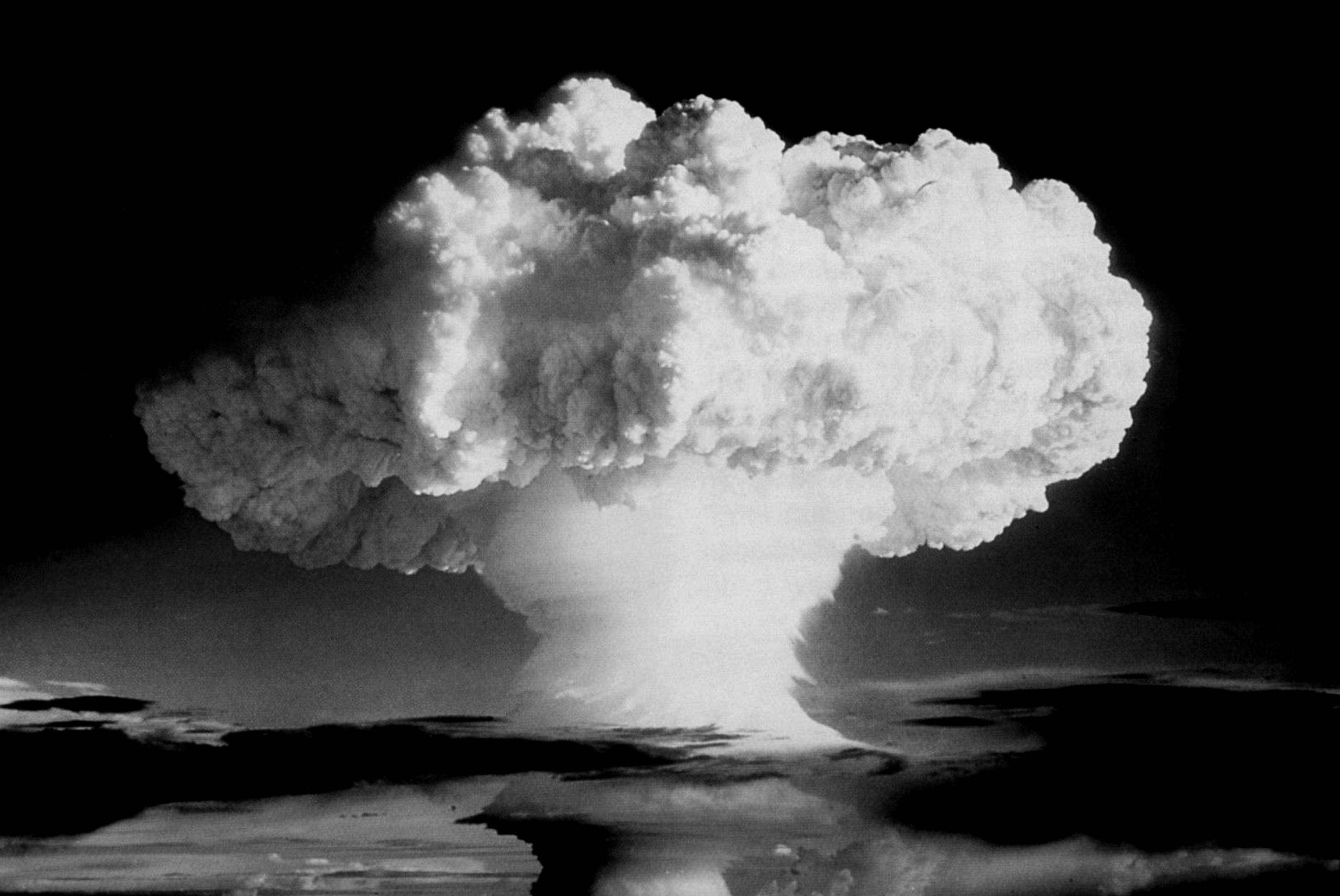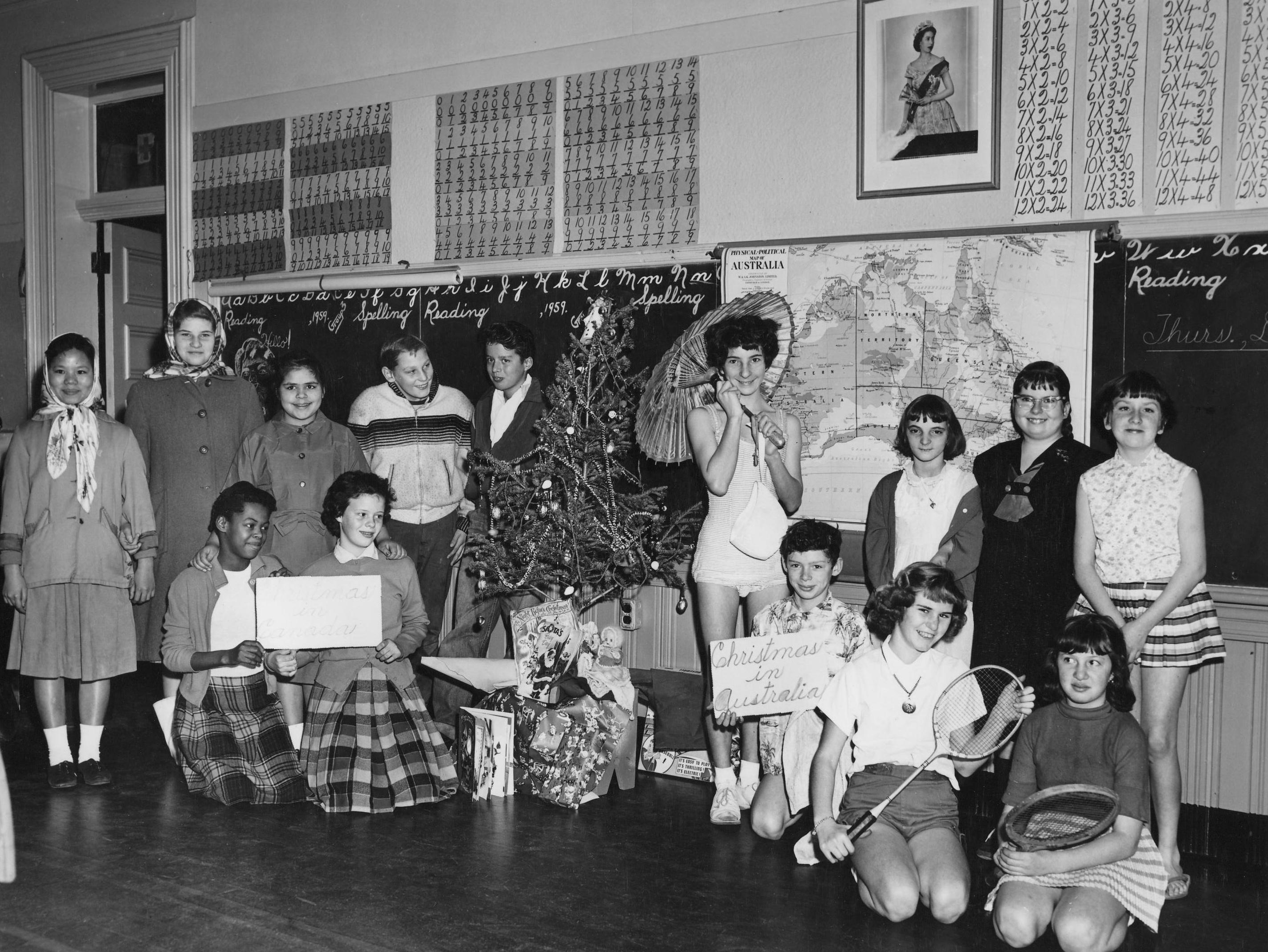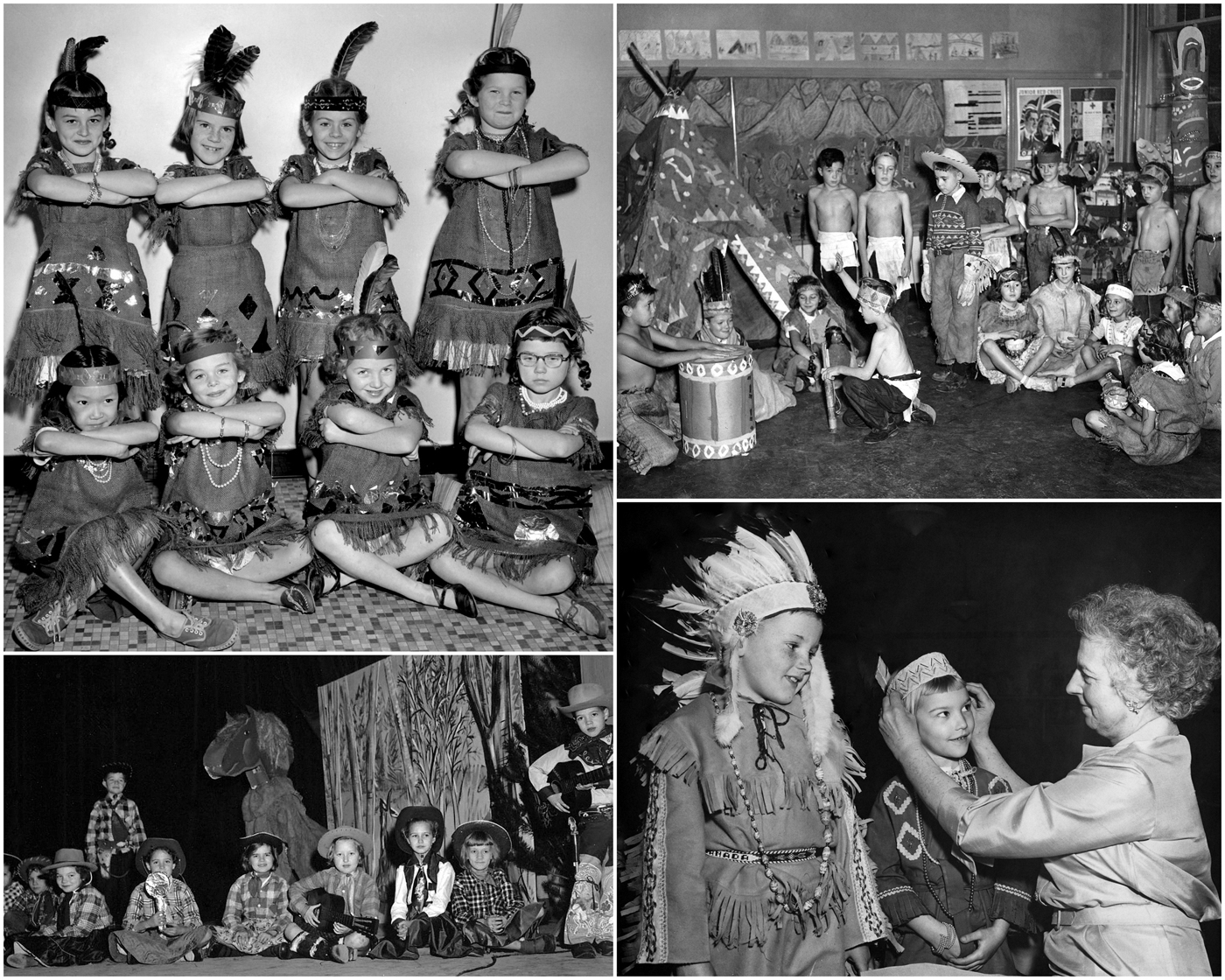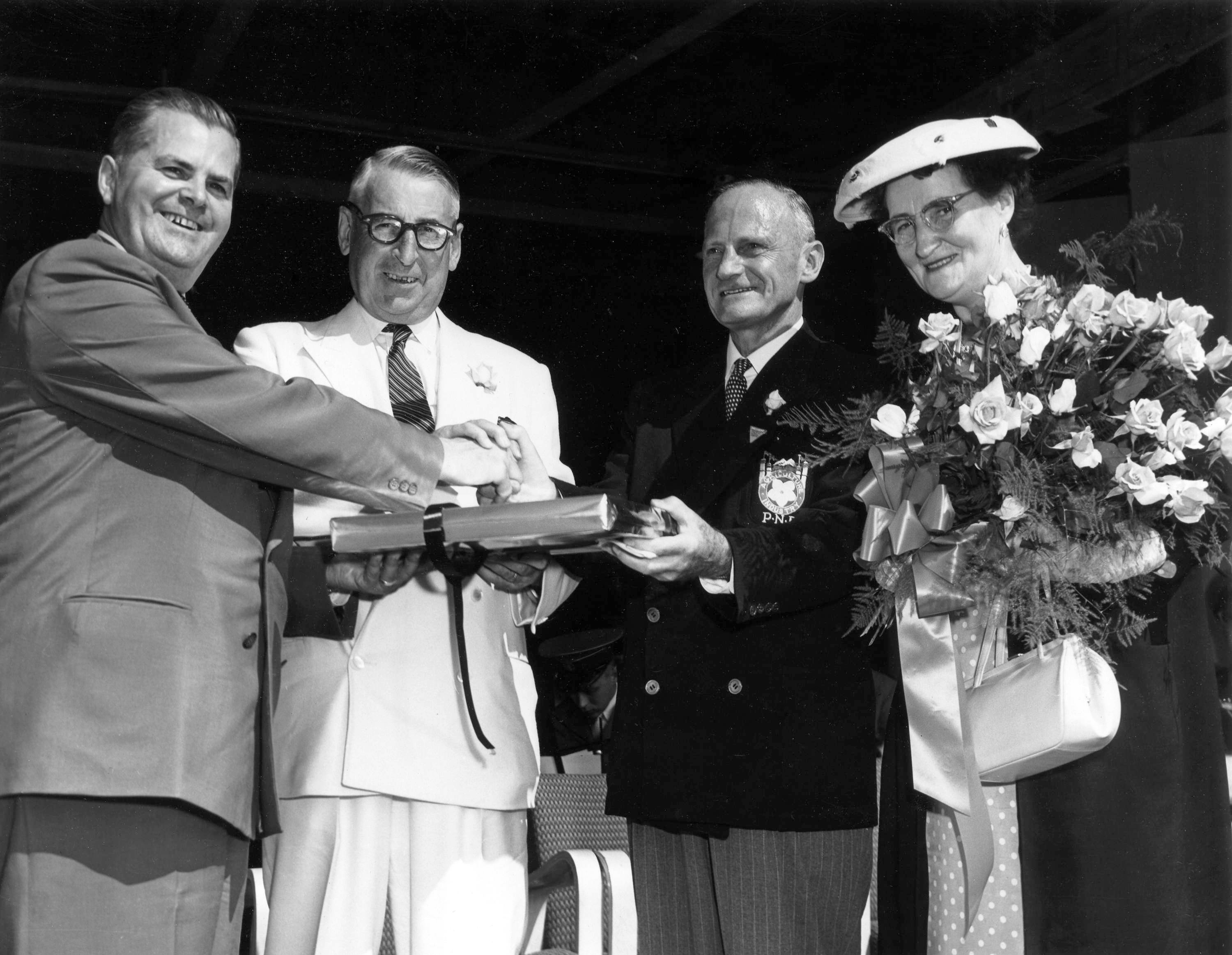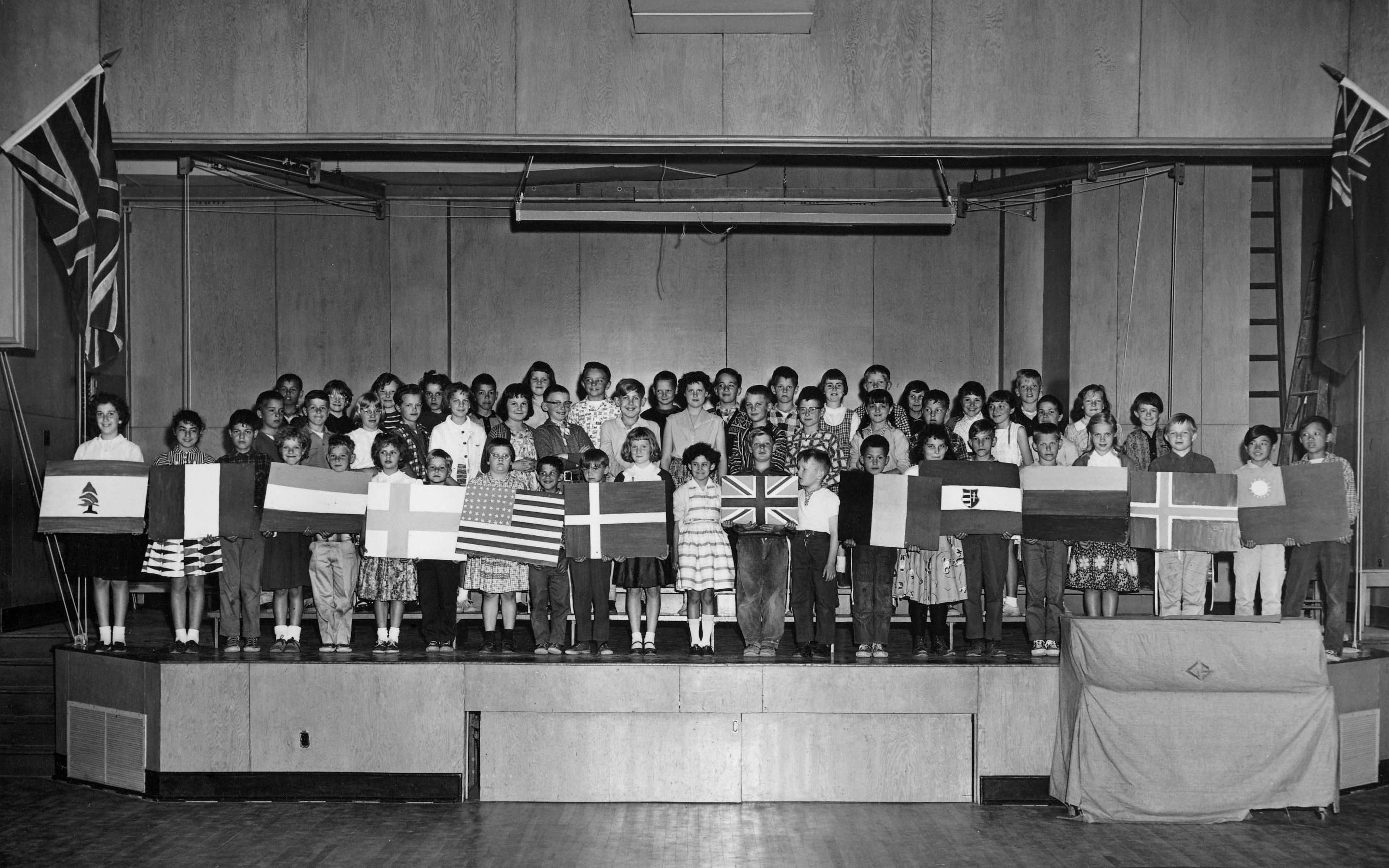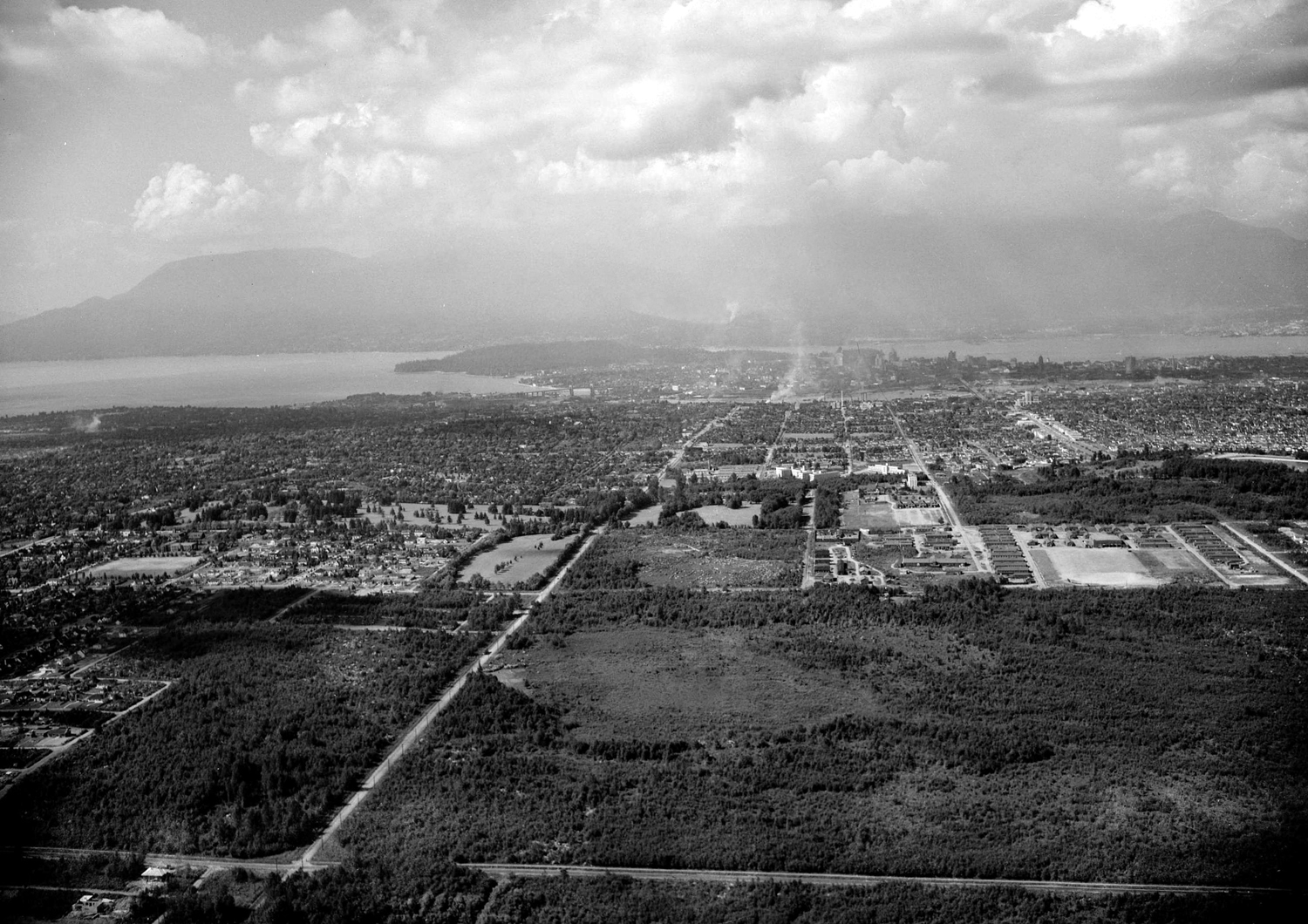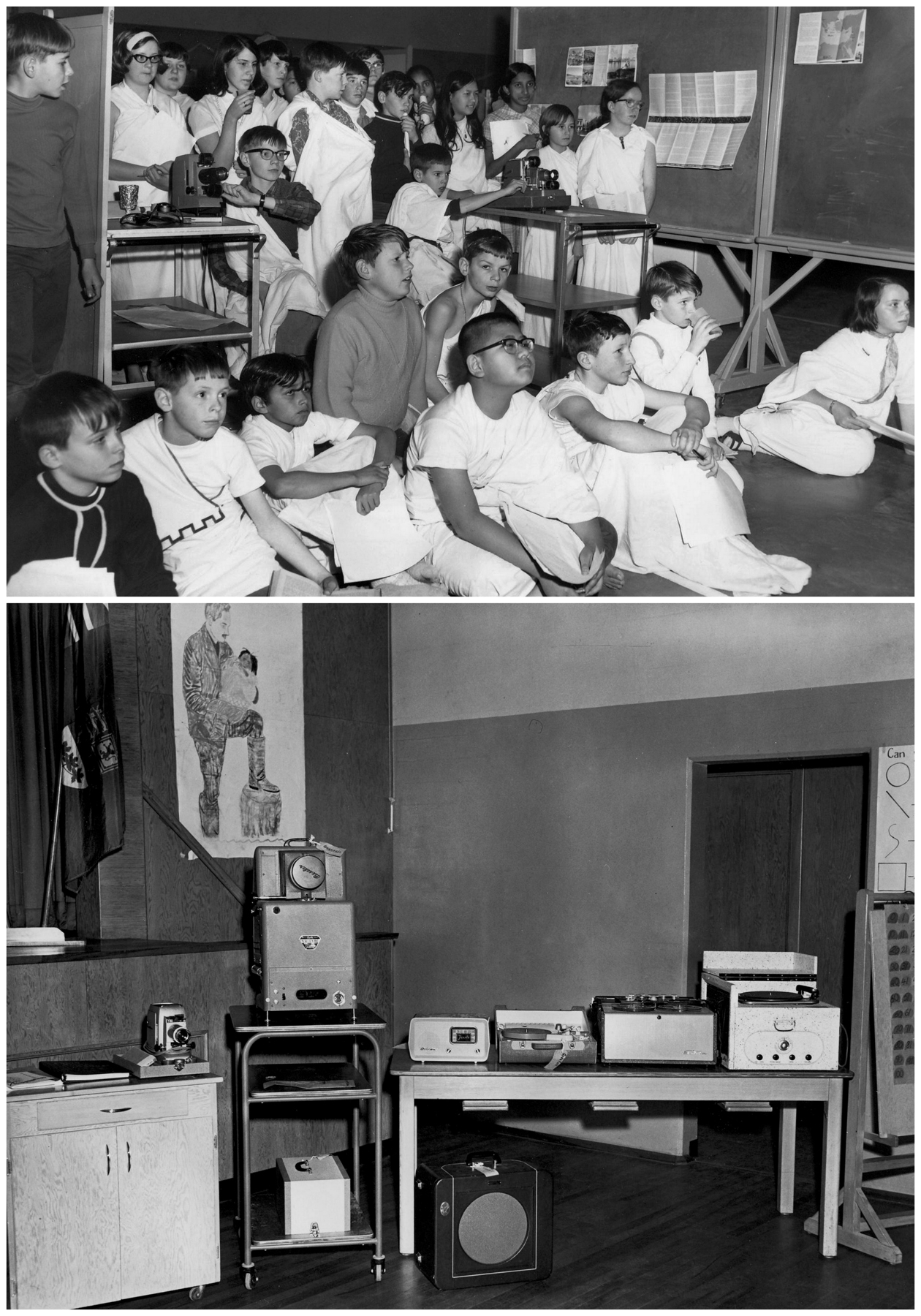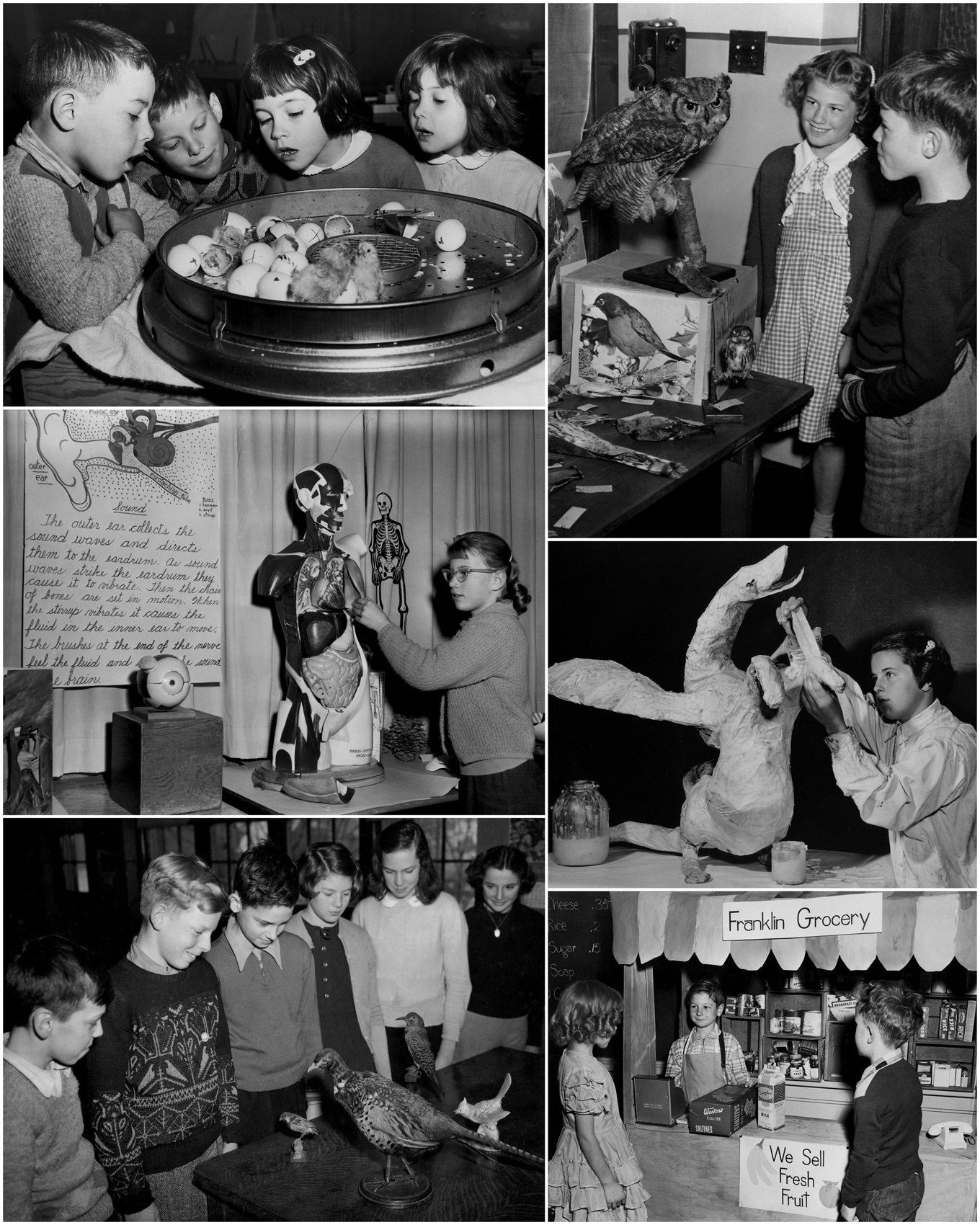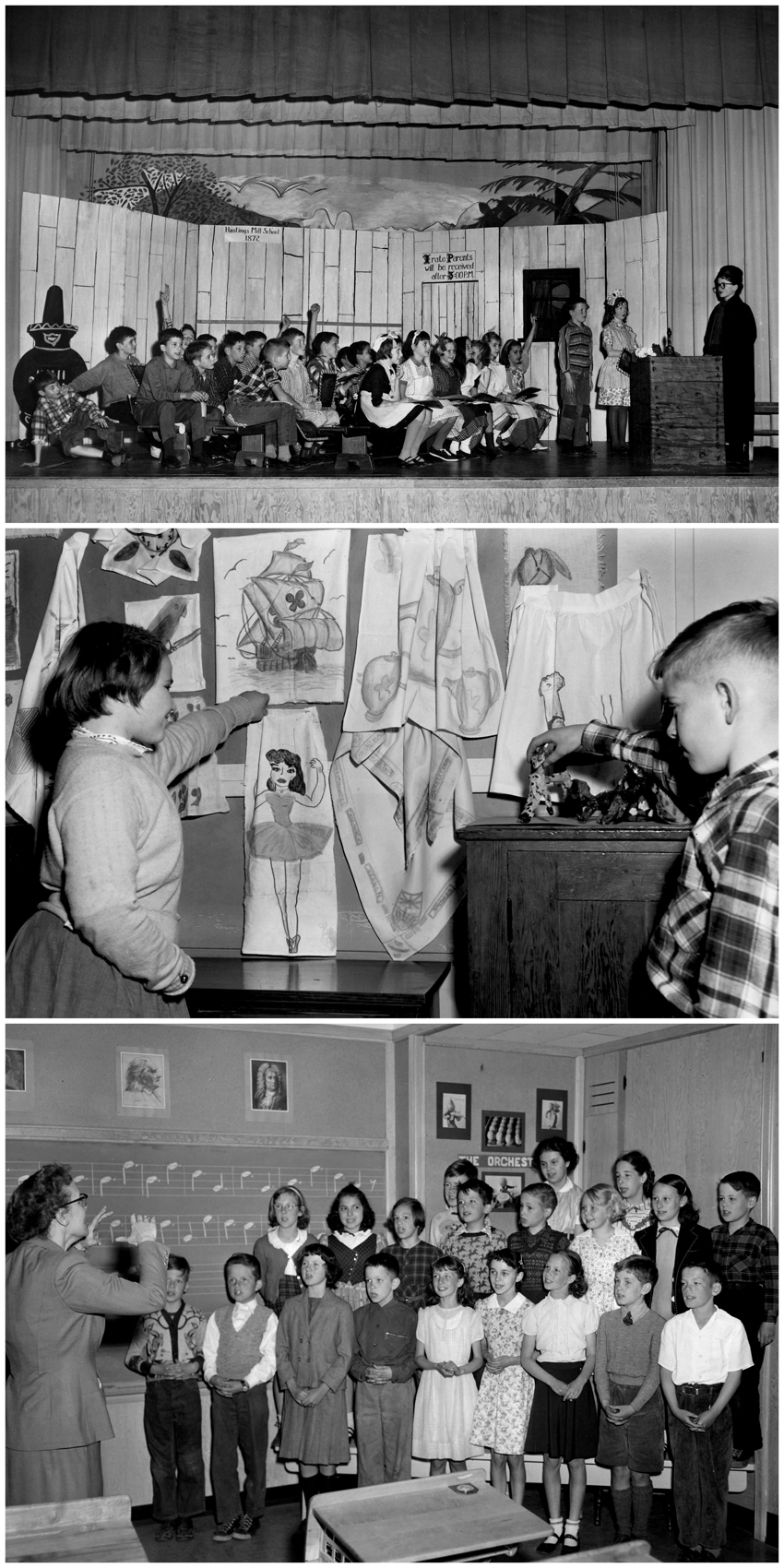Chapter Five: The Fifties
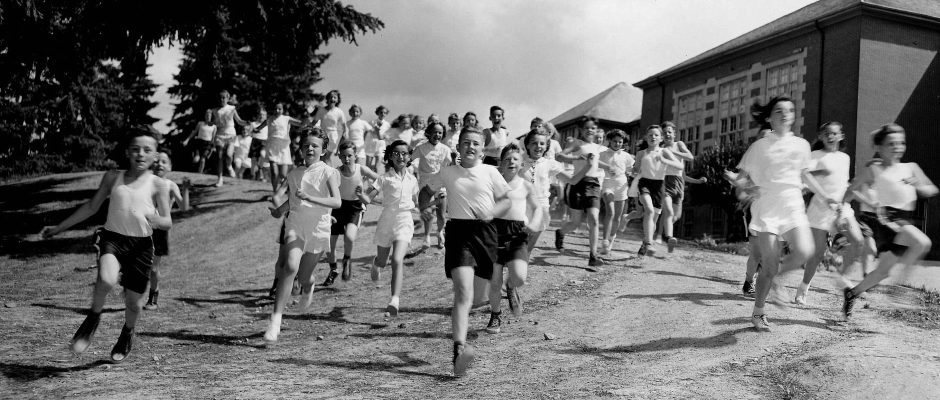
Introduction
During the 1950s, Vancouver experienced an economic boom, rapid growth, a dramatic rise in the school population, an increase in ethnic and cultural diversity, and the threat of annihilation in a global nuclear war. The children who entered school during this decade were part of an enormous post war ‘baby boom’. The rapid rise in the number of school-age children posed a huge challenge to the Vancouver School District. The economic prosperity of this time coupled with the increasing availability of new homes, automobiles, and new products such as electrical home appliances and television produced a consumer society strongly influenced by American values and culture.
I. World Events
Date: November, 1952 USA: First Atmospheric Hydrogen Bomb Test, November 1952. The Soviet Union detonated a similar device nine months later.
A. ‘Grand Alliance’ to ‘Cold War’
By 1951, the Grand Alliance of the United States, Great Britain, and the Soviet Union, which formed during World War Two to defeat the Axis Powers of Germany, Italy, and Japan, was broken. The United States and Great Britain, Canada, and several Western European countries had formed a mutual defense pact called NATO (North Atlantic Treaty Organization) to protect Western Europe from Soviet aggression. In 1955, the Soviet Union countered by forming the Warsaw Pact, a military alliance that included seven Soviet satellite states in Eastern Europe. The rivalry between these two alliances was to last for decades.
In China, in October 1949, Communist forces defeated the Nationalist rivals after a lengthy civil war, and their leader, Mao Zedong, proclaimed the creation of the People’s Republic of China. In June 1950, war broke out in the Korean peninsula when armies from communist North Korea, invaded South Korea. A United Nations military force led by the United States stopped the invasion, and then attacked North Korea. Communist China countered by sending armies into North Korea to counter the UN forces. In July 1953, an armistice ended the fighting, but a peace treaty was never agreed to. The Korean peninsula remains divided between two rival states to this day.
The rivalry between the ‘Communist World’ and ‘Non Communist World’ was to last for decades. It was known as the Cold War because open combat between the rival alliances never happened. However, the Cold War sparked a potentially catastrophic arms race. Several countries began to develop and stockpile powerful nuclear weapons. Testing of these weapons continued for several decades, resulting in the release of huge quantities of dangerous radioactive material into the atmosphere.
In September 1957, Canada joined NORAD (North American Air Defence Command), which oversaw the construction and operation of radar systems in Alaska and Canada’s far north. Their purpose: to provide early warning of a Soviet attack on North America.
The threat of nuclear war was heightened when Intercontinental Ballistic Missiles (ICBMs) were developed to augment long range nuclear bomber forces. These missiles could reach targets half a world away in less than 30 minutes, and could not be recalled once launched. This increased the possibility that a full-scale nuclear war could erupt by accident or through miscalculation.
In Vancouver, school children were made well aware of the terrible threat they faced through conversations they overheard at home, newsreels they sat through in movie theatres, television news they may have seen at home, and Air Raid drills they practiced at school.
Excerpt from A SHORT HISTORY OF BC EDUCATION
1951 The first chills of the Cold War are evident in the provincial education system. In September 1951, a course of lectures on Civil Defence Affairs is organized at the {Provincial Normal School in Victoria. The next year, the Department of Education issues a poster on what to do “If An Air Raid Comes Without Warning.” “Get Under Your Desk – Move Fast!”
Photo at right: Students at Lord Selkirk Elementary practice moving an injured person onto a wheeled stretcher, under the watchful gaze of members of the Vancouver Fire Department. Date: 1954.
B. The Space Race and Its Impact on Education
The Cold War rivalry between Communist and Non Communist powers went beyond the arms race. They competed in other areas such as sports, economic development and propaganda. On October 04, 1957, the Soviet Union launched the first satellite, Sputnik I, into Earth orbit. This set off a ‘space race’ between the United States and the Soviet Union, which culminated in the US Apollo 11 mission – the first landing of humans on the Moon’s surface. The space race led to calls for more emphasis on science and mathematics education in North American schools.
Excerpts from 100 Years of Discovery: 1950 – 1959 (2015 Fall Feature Story – The University of British Columbia):
Soviet ‘scientific success’ and the Space Race puts the focus on science from K – 12 and in higher education, but it also instills a nagging uncertainty as Western educators try to ‘catch up’ to their Soviet Bloc counterparts.
To incentivise academic achievement in the province, Premier W.A.C. Bennett introduces a scholarship program that provides up to 50 percent of school fees for students with first-class standing.
Excerpt from the Commonwealth Report:
When the first Sputnik satellite was launched by the Soviets in 1957, putting them ahead of the Americans in the race for space, many pointed to the ‘lax’ school system as the cause. Thus, when the Vancouver School Board went to the voters in 1957 to ask for funding to build new schools, its advertisements read ‘Catch Russians: Money for Education.’
II. Canada in the 1950s
A. The British Connection
Up until 1947, persons born in Canada and naturalized immigrants were classified as British subjects. The Canadian Citizenship Act of 1947 changed this. It created the category ‘Canadian citizenship’. Residents of Canada could now claim Canadian citizenship regardless of their country of origin. Canada’s connection to Great Britain remained strong. This was evident in the respect and admiration most Canadians held towards the British Royal Family, and their pride in Canada’s prominent place in the British Empire.
Date: 1959 Top: Students at Admiral Seymour Elementary pose with letters to their Australian pen pals. Bottom: Another group of students at Admiral Seymour Elementary pose as ‘typical’ Australians.
This strong connection continued as the British Empire evolved into a Commonwealth of independent states. It was bolstered by a surge of British immigrants to Canada during the early 1950s (in 1951, 44 percent of all immigrants to Canada were from Great Britain), and fostered by a series of Royal visits to Canada. British Columbia was a popular and frequent destination for members of the Royal family.
Royal Visits to British Columbia during the 1950’s:
1951 Princess Elizabeth and Prince Philip;
During her stay in Vancouver, Princess Elizabeth planted a tree in Queen Elizabeth Park, named to commemorate her mother Queen Elizabeth’s visit to Vancouver in August 1939. Photo Credit: City of Vancouver Archives.
1954 Prince Philip, Duke of Edinburgh
Prince Philip attended the 1954 British Empire and Commonwealth Games that were being held Vancouver, July 30 – August 07.
Interesting Facts:
– The Games were formally opened by the Earl Alexander of Tunis, a former Senior British Army officer, and a citizen of Great Britain.
– From 1930 – 1950, the games were known as the British Empire Games
– Empire Stadium was built for the 1954 Games. It hosted 29 athletic events.
Date: August 1954 Photo Credit: Canadian Broadcasting Corporation.
1958 Princess Margaret; Queen Elizabeth the Queen Mother
Cross Canada tour with several stops in BC to mark the 100th Anniversary of BC becoming a British Crown Colony; later the same year, Queen Elizabeth, the Queen Mother made an overnight stop in Vancouver.
Photo Credits: City of Vancouver Archives.
1959 Queen Elizabeth II and the Duke of Edinburgh (Cross Canada tour)
PHOTO COLLAGE: VANCOUVER SCHOOLS CELEBRATE THE 100th ANNIVERSARY OF BC BECOMING A BRITISH CROWN COLONY
B. The Rise of American Popular Culture
Despite the popularity of the Royal Tours in Canada during the 1950s, British cultural influence on Canada waned as the United States established itself as a dominant cultural force in Canada. This influence was felt especially in the realms of popular culture: television shows, movies, and pop music.
TELEVISION: Beginning in the late 1940s, television exploded in popularity. In the United States, the number of commercial television stations rose from 98 in 1950, to 233 in 1954, to 440 by 1960. Three television networks dominated broadcasting: NBC, ABC, and CBS. Cowboy shows dominated the schedules. Their popularity peaked in 1959 when 26 cowboy shows aired during prime time each week. Canada’s first network, the Canadian Broadcasting Corporation, didn’t begin operation until 1952. Due to the popularity of American shows in Canada, TV shows produced in Canada often struggled to find an audience, despite the fact that the number of television sets in Canada rose from 146,000 in 1952 to 2.3 million in 1956.
MOVIES: British movies continued to be popular in Canada, but the American film industry continued to dominate, even as it struggled to compete with the growing popularity of television shows. The production of cowboy movies, and Innovations such as wide screens and 3D, and the production of spectacle films with historical and religious themes were introduced in an attempt to win back movie audiences.
Very little film production happened in Canada. The National Film Board, established in 1939, won some international acclaim for its production of animated films and documentaries.
THE LONE RANGER’S CANADIAN “SIDEKICK”
Harold J. Smith, aka Jay Silverheels, was born on a reserve in 1912. A gifted athlete, he was a champion boxer and wrestler, and a top scorer on the Canadian National Lacrosse team. He appeared in dozens of films, mostly westerns, as a stuntman and bit player. Most were low-budget and poorly produced. In 1945, he took the name Jay Silverheels, his last name being a nickname given to him by his team mates on the Canadian National Lacrosse team.
His breakout opportunity came in 1949 when he won the role of Tonto in the television series The Lone Ranger. It became an enormous hit, and Silverheels and Clayton Moore, who played the Lone Ranger, became household names. Silverheels later criticized his Tonto role for dialogue that made him look dim-witted. He also criticized Hollywood’s practice of casting non-Indigenous actors in Indigenous roles.
During the 1960s, Silverheels was attacked by Indigenous activists for his Lone Ranger’s “sidekick” persona. The fact that he had begun playing his Tonto persona for laughs only worsened the criticism. Critics called him “Uncle Tomahawk” and the “Indian Stepin Fetchit.” Yet, he helped establish the Indian Actors Workshop, a place for training Indigenous actors and provided a political voice on First Nations issues.
PHOTO COLLAGE: Possible evidence of the influence of American films and television on Vancouver schools during the 1950s.
POP MUSIC:
Excerpts from ‘Rock ‘n’ Roll and Social Change’
by Richard Welch
Published in History Today Volume 40 Issue 2 February 1990
Yet one of the most profound cultural changes in American history is seldom credited for what it was and did. In the mid-1950s this enormous cultural revolution swept aside prevailing notions of American popular music, blended black and white musical traditions and integrated black performers into the pantheon of musical superstars in an unprecedented fashion. In such a way this revolution both presaged and encouraged the desegregation movement of the 1956-64 period. More generally, this revolution created a music which became the common property not only of two generations of Americans, but millions throughout the world, creating the most ubiquitous, and perhaps, most influential form of American popular culture. The revolution was rock ‘n’ roll.
The startling success of rock ‘n’ roll in transforming American popular music and culture owed much to the phenomenon of the mass-market adolescent subculture. While adolescence is normally a time of some rebellion against adult authority and mores, nothing seen before in history was quite as dramatic as the transformation of adolescents from an age group to a virtual class after the Second World War.
Excerpt from ELVIS HISTORY BLOG: http://www.elvis-history-blog.com/elvis-vancouver.html
On August 31, 1957, Elvis Presley gave one of the most legendary concerts of his career at Empire Stadium in Vancouver, B.C. It would be his last performance outside the U.S. Crowd estimates ranged from 16,000 to over 26,000. Either way, it was the biggest crowd he faced in 1957. Thousands of spectators left the stands and charged down the football field before halting just short of the goal line, where Elvis gyrated on stage. Fear that the excited crowd might advance on the stage caused Elvis to cut his performance down to 22 minutes, about half his normal time on stage in 1957. After Elvis split, hundreds of fans burst through the security line and overran the stage. Eventually the crowd dispersed, and Elvis’s Vancouver show passed into history.
C. The Economy
In the 1950s, Canada’s economy grew at a fast pace, fueled by new resource-based development (coal, oil and natural gas, forest products, prairie wheat) and rising consumer demand. The Port of Vancouver saw rapid growth as trade with Japan and other overseas countries expanded.
The standard of living of most Canadians rose dramatically. This period of unprecedented economic prosperity continued well into the 1960s. Canada’s economy became more integrated with the American economy through trade agreements which saw the lowering of trade barriers.
In the 1950s, many young people were coming of age in an era of relative abundance. Goods that families couldn’t afford in the 1930s and couldn’t purchase in the 1940s due to wartime restrictions on production were becoming more common. New consumer products, too, were entering the market. Between 1950 and 1960, homes in Canadian cities and towns acquired items such as automatic washing machines and electric refrigerators (rural homes often didn’t have the electricity and plentiful running water these appliances required). New automobiles were increasingly abundant and affordable. Televisions were growing in popularity; the children of the 1950s were the first to grow up with access to this medium, which brought advertising into the home in a new and — some believed — invasive way.
(Excerpt from YOUTH AND CONSUMERISM by Katharine Rollwagen, Department of History, Vancouver Island University)
British Columbia: The Era of William Andrew Cecil Bennett (1952-1972)
Date: 1956 W.A.C. Bennett (far left) and his wife May Bennett (far right) attend a ceremony. Photo Credit: City of Vancouver Archives.
On August 01, 1952, W.A.C. Bennett was sworn in as BC Premier as leader of a Social Credit (populist conservative) Government. He remained in office until September 15, 1972. One of Bennett’s ambitions was to complete a railway linking Vancouver to northern British Columbia:
Bennett’s northern ambitions involved two complementary and sometimes overlapping goals. The first was to develop northern British Columbia as part of his government’s overall aim of hinterland expansion. When Bennett became premier, a general consensus prevailed that settlement and economic activity in British Columbia were too heavily concentrated in the southwest corner of the province.
It mainly connected logging and mining operations of the British Columbia Interior with the coastal town of Squamish, where these resources were transported by sea. Resources were not available for the government to expand the railway to the intended target of Prince George, and to its detractors PGE came to stand for “Province’s Great Expense”, “Prince George Eventually”, “Past God’s Endurance”, and “Please Go Easy”.
Finally beginning in 1949, there were financial allocations that allowed the Pacific Great Eastern to begin to expand. Track was laid north of Quesnel to a junction with the Canadian National Railways at Prince George. Between 1953 and 1956, the PGE constructed a line between Squamish and North Vancouver.
Source: John R. Wedley, A DEVELOPMENT TOOL: W.A.C. BENNETT AND THE PGE RAILWAY
D. IMMIGRATION
The 1950s saw changes in Canadian immigration policy and practices that affected both immigrants and refugees and increased ethnic and cultural diversity in Canadian society.
The following are excerpts from a chronology prepared by Immigration, Refugees, and Citizenship Canada:
1950
- The Department of Citizenship and Immigration was formed.
- Order in Council issued replacing previous measures on immigration selection. The preference was maintained for British, Irish, French, and U.S. immigrants. The categories of admissible European immigrants were expanded to include healthy applicants of good character with skills and who could readily integrate.
1952
- A new Immigration Act was passed… It provided for the refusal of admission on the grounds of nationality ethnic group, geographic area of origin, peculiar customs, habits and modes of life, unsuitability with regard to the climate, probable inability to become assimilated. Homosexuals, drug addicts, and drug traffickers were added to the prohibited classes…
1956
- The crushing of the Hungarian Revolution led to over 200,000 Hungarians fleeing to Austria. In response to public pressure, the Canadian government implemented a special program with free passage… More than 37,000 Hungarians were admitted in less than a year.
1959
- The government restricted admission of family members, in a measure particularly aimed at curbing immigration of Italian family members. The measure was met with loud protests and was rescinded a month later.
Population data from the 1951 and 1961 Censuses
During the 1950s, total immigration to Canada surged dramatically, peaking at 282,000 in 1957, and then declined rapidly during the next 3 years.
Percentage of the Canadian population who were immigrants:
1951: 14.7 percent
1961: 15.6 percent
1951: 44 % of immigrants were from the United Kingdom, 13.7 % from the U.S, 9% from the USSR, and 8% from Ireland. In terms of “ethnic origin”, 97 % were European.
1961: 34% of immigrants were from the United Kingdom, 51% from other European countries (including 9% from Italy). In terms of “ethnic origin”, 98 % were European.
Comparing Canada’s population in 1951 and 1961 by place of birth, the percentage declined for those born in the United Kingdom and the United States, and rose somewhat for those born in Western and Eastern Europe.
Date: 1960 Grandview Elementary School students celebrate their country of origin.
Ethnic and Cultural Diversity in Vancouver
During the 1950s, Vancouver was home to two vibrant ethnic communities:
1. Chinatown
Chinatown’s roots go back to the 1890s, when more than one thousand Chinese lived in a small area of Vancouver bounded by Carrall and Columbia streets. Many of the residents were workers who had come to Canada to help build the Canadian Pacific Railroad. By 1910, more than 3500 Chinese lived in Vancouver, the large majority in Chinatown, and a small number in the adjoining Strathcona District to the east.
Relations between the Chinese and non-Chinese in Vancouver were fraught:
- In 1885, the Parliament of Canada passed the Chinese Immigration Act of 1885, which required Chinese persons entering Canada to a fee of $50, a considerable sum for the time. By 1904, the fee had been raised to $500.
- In September 1907, white supporters of the Asiatic Exclusion League invaded Chinatown where they assaulted Chinese residents and caused extensive damage to buildings.
- Following the passage of the 1923 Exclusion Act by the Parliament of Canada, Vancouver’s population declined from 13011 in 1931 to 7174 in 1941.
During the 1950s, the Chinese population of Strathcona grew as white residents moved to neighborhoods considered more attractive. By 1957, Chinese residents comprised about half the population of the Strathcona District. Students of Chinese heritage came to form a majority in Strathcona Elementary School and Britannia High School.
2. Little Italy
During the 1940s and 50s, the majority of Italian immigrants to Vancouver settled in neighbourhoods bordering Commercial Drive. Businesses and cultural institutions run by Italians became a common sight along the Drive and the area became a true ethnic enclave. Students of Italian heritage formed a large part of the population of local elementary and secondary schools until well into the 1970’s. In 2016, a formal ceremony was held to recognize the northern stretch of Commercial Drive as Little Italy. By that time Italian influence in the area had declined due to the arrival of other ethnic groups and the movement of families of Italian origin to other areas of Greater Vancouver.
III. Developments in the Vancouver School District
In 1952, the Vancouver School Board moved its offices from the building it had occupied in Downtown Vancouver, since 1910, to a new, modern facility at 1595 West 10th Avenue. It was a timely move. This allowed the Vancouver School of Art to move from the old Vancouver High School building into the now vacant building. More important, the Vancouver School District was grappling with a huge increase in new students – the ‘Baby Boomers’ – those born in the years following the end of World War Two in 1945. In order to meet the demand, many new schools would have to be built, and existing schools would have to be expanded and upgraded. Much of this activity would be happening south of West 16th Avenue, the old, southern boundary of the Vancouver School District until 1929.
For more information on the history of the Vancouver School Board offices, follow this link:
The Vancouver School Board over the Years: Different Locations; Different Buildings
A. The BABY BOOM
Kerrisdale Elementary School, 1954
In his report to the Superintendent of Education for 1950-51, H. N. MacCorkindale, the Superintendent of Schools for the Vancouver School District made the following observations:
War Period (1940 to 1945, Inclusive)—For this six-year period, the average of the annual births domiciled in the City of Vancouver was 6645. This is an average annual increase of approximately 76 per cent over the pre-war period. By September next, practically all the children born in the war period will be enrolled in the first six grades of the elementary schools. A check on the enrollment shows that this elementary-school group is approximately 76 percent above the enrollment of the secondary-school group.
Post-war Period (1946 to 1950, Inclusive)—The average of the annual births for this five-year period rose to 9,813, an average annual increase over the pre-war period of approximately 160 per cent. In September, 1952, those born the first year of the post-war period will enroll in Grade I. This indicates that the year 1952 constitutes the beginning of a period of the most rapid increase in future school enrolment in this district. This trend has not been local, but is world wide
Excerpts from the Commonwealth Report
Writing about the history of the baby boom generation, historian Doug Owram points out that most authorities seriously underestimated the size of the boom, believing that it would be a short-lived phenomenon…
The Board’s 1945 predictions were based on past trends; the baby boom defied these trends. It was the product of a number of factors: post-war prosperity and strong social pressures – and desire, after years of war – to marry. These factors, and a relatively large number of men and women of ‘marriageable age,’ combined to mean that in 1946’ more families were formed than ever before in Canada.
Thus, in addition to planned veterans developments, there was also, throughout Vancouver, a general intensification of residential development, with the tracts of empty land and the numerous empty lots within the existing city boundaries filled in through the 1950s and into the 1960s.
Most residential areas within Vancouver were developed as low density neighbourhoods whose residents lived in single family dwellings and depended on the automobile as their primary means of transportation. The Oakridge area was one of the last parts of Vancouver to be developed. The Oakridge Centre shopping mall, which opened in 1959, spurred a residential construction boom in the surrounding areas.
Date: 1948 Looking north across the vacant land that would become the Oakridge Centre shopping mall and the Oakridge residential area. Photo Credit: City of Vancouver Archives
B. BOON TIMES IN SCHOOL CONSTRUCTION
The baby boom and rapid development of low density single family neighbourhoods presented the Vancouver School Board with a huge challenge. A major building program would have to be launched immediately to provide enough classrooms and other facilities to meet the educational needs of the Baby Boomers. One factor that operated in favor of the Vancouver School Board: a majority of the City’s residents supported the raising of local taxes to cover the costs.
The School Board responded to this pattern of development first by expanding and modernizing many existing schools. As a result, many Vancouver schools have a classroom wing or auditorium/gymnasium/lunchroom built during the 1950s and 60’s. Many neighbourhoods with pre-war schools also saw small primary annexes guilt to absorb overflow.
1. The following passage outlines the construction activity going on in the Vancouver School District for just one year during the 1950s:
EXCERPT FROM THE REPORT OF H. N. MacCORKINDALE, B.A., LL.D., SUPERINTENDENT OF SCHOOLS (1953-54):
Since 1946, the City of Vancouver, School District No. 39, has had a long-term plan for school construction endorsed by the taxpayers of the district. This long-term policy has made it possible for the Vancouver Board of School Trustees to plan economically over the years, and, at the same time, provide for any emergency that might arise from general city growth. I am pleased to report that most of the classes on double shift have been eliminated.
According to the present figures available, from the birth-rate tables and reports on the influx of population, such a long-term plan will have to continue for many years. During the next six years in this district the average annual growth of the school enrolment elementary and secondary) will be nearly 3,500. This means that the average number of new classrooms required to meet the increase will be at least 100 rooms per annum.
SCHOOL BUILDINGS
The following buildings were completed during the school-year 1953-54:
Lord Nelson No. 2 Elementary School: Seven classrooms.
Maple Grove Elementary School Addition: gymnasium, lunchroom.
Portables (Elementary): Eight classrooms.
Nightingale Elementary Addition: Gymnasium-auditorium, lunchroom.
Renfrew Elementary Addition: Seven classrooms.
Templeton Junior High School Addition: One Home Economics room, extension to gymnasium.
Extra accommodation in existing schools: Fifteen classrooms.
The following buildings were under construction during the school-year 1953-54:
John Oliver High School Addition: Twenty-two classrooms, four shops, five Home Economics rooms, cafeteria, auditorium.
Osler Elementary Addition: Eight classrooms, lunchroom.
McBride Elementary Addition: Gymnasium-auditorium, lunchroom.
Additions to Technical School: Twenty-seven classrooms, double gymnasium, cafeteria. Britannia High School Addition: Five classrooms, shop, double gymnasium, cafeteria. Douglas No. 2 Elementary Addition: Ten classrooms.
David Lloyd George Elementary Addition: Six classrooms, gymnasium-auditorium.
Lord Roberts Elementary Addition: Gymnasium-auditorium, lunchroom.
Queen Mary Elementary Addition: Three classrooms, gymnasium-auditorium, lunchroom.
Portables: Twenty-six classrooms
Plans are being prepared for the following:
Sir Winston Churchill High School: Thirty-five classrooms, five shops, four Home Economics rooms, double gymnasium, cafeteria.
Sir Charles Kingsford-Smith Elementary School: Sixteen classrooms, lunch room, gymnasium-auditorium.
Brock Addition: Six classrooms, gymnasium-auditorium
Quilchena Elementary Addition: Four classrooms, gymnasium-auditorium.
Norquay No. 2 Elementary Addition: Eight classrooms, lunchroom, gymnasium-auditorium. Livingstone Elementary Addition: Six classrooms, lunchroom, gymnasium-auditorium.
Carleton No. 2 Elementary Addition: Eight classrooms, gymnasium auditorium.
Laurier Elementary Addition: Four classrooms, gymnasium-auditorium.
Sexsmith Elementary Addition: Six classrooms.
Southlands Elementary Addition: Six classrooms.
Special tribute is due to the Director of Building Construction and Maintenance Mr. E. D. King, and his staff, for the splendid work which has been done in order to keep pace with the rapidly expanding needs of the system.
2. The relationship between School Design and Educational Programing
Excerpts from the Commonwealth Report:
FUNCTION SHOULD DICTATE FORM
Superintendent H.N. McCorkindale also expressed clear ideas about school architecture and architects. Quoting from an ‘outstanding school architect’ he asserted that post-war schools should not be balanced in either plan or elevation. Rather, the plan of the school should emerge from function. The plan should grow out of the school activity rather than the school activity conform to a preconceived plan.
How these ideas were implemented in Vancouver is spelled out quite succinctly in the Board’s 1955 Annual Report, which stated that Board architect E.D. King aimed for simplicity of design and the use of economical materials. Schools were built without basements, attics, or ornamentation. The interiors were made attractive with a) lively colour combinations b) modem efficient lighting units c) coloured asphalt tile or marboleum on the floors d) tile washrooms e) greater tackboard areas f) improved classroom furniture g) acoustical tile where ever required to affect proper control sound and control.’ The economy of Vancouver’s approach was confirmed through research, which demonstrated it had one of the lowest costs of construction per square foot on the continent. With the exception of the primary annexes, which were of frame construction with plywood interior walls, all elementary and secondary school buildings were constructed of reinforced concrete, with pumice brick partitions. From 1963 onwards the annexes were also built of fireproof materials — steel frame and concrete and brick infills, with roofs of prestressed and precast concrete and walls of precast concrete with exposed aggregate. This followed a fire at Edith Cavell Annex in the late 1950s, which completely destroyed it. The economy of construction must have been of some comfort to sceptics; not all school authorities were convinced of the direct relationship between good schooling and good school buildings. Vancouver’s Supervisor of Instruction commented in 1950 that ‘good equipment and classrooms are very helpful, but these have very little influence if the teaching is not strong.’Architectural historian Rhodri Windsor Linscombe describes the ‘socialized architecture polemic’ that emphasized the role of the architect as organizer rather than stylist, as the main idea that infused architecture, and informed school design in western Europe and North America in the 1940s and 1950s.
HIGH SCHOOLS PROGRAMS SHOULD BE COMPREHENSIVE
In the 1950s, Vancouver built five new secondary schools (Gladstone, Sir Winston Churchill, Killarney, David Thompson, and Sir Charles Tupper) and modernized its existing high schools. Continuing a policy begun in 1938, it combined junior and senior high schools at single sites, and using federal monies (this also began pre-war), it developed its vocational programs… The result was the creation of comprehensive (or composite) high schools that offered a wide range of courses and programs to a diverse student body, rather than specialized high schools that offered only academic, vocational, or commercial courses…
The increased enrollment reflected the fact that the general population attached more importance to obtaining a high school education. More students were starting and staying in high school through to graduation…
Specialized rooms including art, science, music rooms, and libraries, were added to many elementary schools in modernization programs undertaken in the 1950s, completing a process begun in the 1930s as elementary schools adopted the platoon system. These spaces were intended to help to foster a more flexible, activity based education…
Progressivism also provided an impetus to those interested in addressing the needs of children not well provided for in the standard classroom… This led to the establishment of classes for mentally and, later, physically disabled children… In the 1950s, its work continued, albeit with a more progressive child-centred rationale, with the establishment of enriched classes for the gifted… and the introduction of French at the elementary level at Queens Mary and Elizabeth Schools and Lord Kitchener School…
3. Solutions to the Teacher Shortage
Excerpts from A SHORT HISTORY OF BC EDUCATION
1954 September: British Columbia experiences a critical shortage of teachers. To meet the need for more teachers, the Department of Education initiates a recruiting campaign in Britain (which nets 65 teachers for the start of the 1955 school year.) Campaigns to recruit British teachers will continue over the next decade.
Elementary schools in the post-war period saw a shift in staff demographics. The shortage of teachers forced school administrators to allow married female teachers to continue their careers. At first, married women were hired only on temporary contracts, but beginning in 1955 they could be appointed to the permanent staff…. Women were required to leave their jobs 5 months before giving birth and to stay away for a full year.
Excerpts from BRITISH COLUMBIA HISTORY OF EDUCATION TIMELINE
1954: Future Teacher Clubs are established in provincial high schools as a means of attracting more teachers into the system. Initially, 87 clubs are organized with a membership of about 1,600.
1956: Teacher education is reorganized and given legislative sanction through amendments to the British Columbia University Act, the Public School Act, and the Victoria College Act, and the Victoria College Act.
All teacher education (elementary and secondary) is transferred from Provincial Normal Schools to a new College of Education. The College of Education operates as a faculty within the University of British Columbia in Vancouver and as a department of Victoria College in Victoria.
NEW SCHOOLS
Twelve new elementary schools, 5 secondary schools and 1 annex were built during the 1950s. Compare this to the 1930s and 40s, when no new schools were built, and the 1970s and 1980s, when no new high schools were built, and only 6 new elementary schools were built.
1951
1952 Sir Wilfred Laurier Southlands Trafalgar
1953
1954 Grandview Sir William Osler
1955 Sir Charles Kingsford Smith Sir Wilfred Grenfell
1956 Capt. James Cook
1957 Dr. R.E.McKechnie
1958 David Thompson
1959 Chief Maquinna David Oppenheimer Tecumseh Annex
1960 Shaughnessy
PHOTO COLLAGE: NEW ELEMENTARY SCHOOLS
PHOTO COLLAGE: NEW HIGH SCHOOLS
C) EDUCATION OPPORTUNITIES BEYOND HIGH SCHOOL
During the 1950s, the Vancouver School Board continued to oversee the operation of the Vancouver School of Art, which now occupied the former offices of the Vancouver School Board.
For more information, follow this link:
The Vancouver School of Art – a Brief History
The Vancouver School Board also oversaw the construction and operation of the Vancouver Vocational Institute (1949 – 1960). VVI provided much needed technical education and pre-employment training in a wide variety of areas such as the building trades, health care, culinary arts, hospitality, and transportation services.
For more information, follow this link:
The Early Years of the Vancouver Vocational Institute – BUILDINGS AND PROGRAMS
PHOTO GALLERIES
Elementary Schools
Secondary Schools

